After many weeks of testing and experimenting, here is my final The Army Painter Speedpaint review. Are they really better and cheaper than Contrast or is it just a YouTube hype?
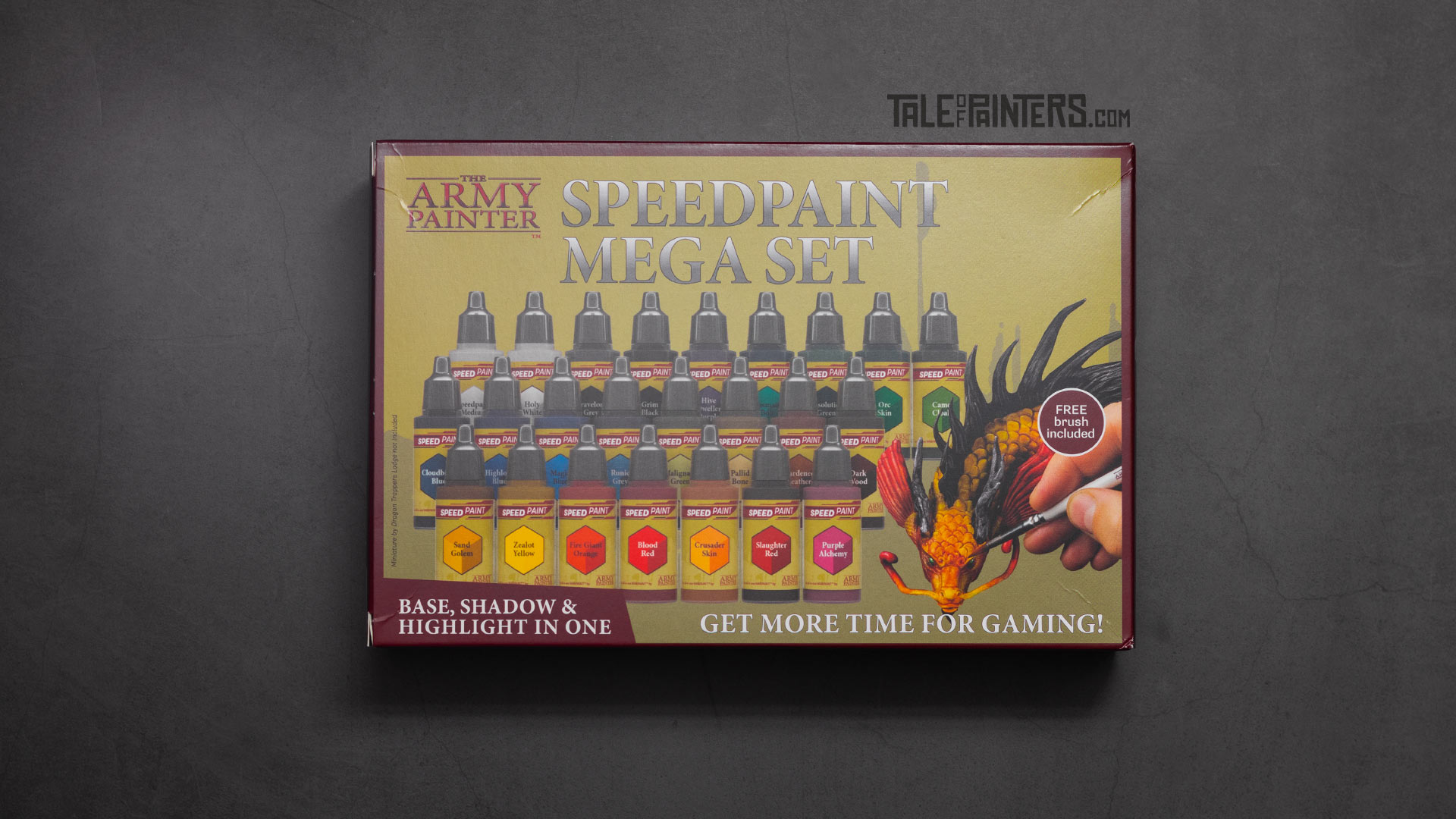

The Army Painter sent me the upcoming Speedpaints Mega Set with all 23 Speedpaints, Speedpaint Medium, and a free brush. The Speedpaint Starter set will be out today on February 19, 2022, and the Mega Set will follow in March. Like Contrast, individual Speedpaints contain 18 ml of paint but come in dropper bottles with two mixing balls pre-installed. They are priced very competitively at 4€ / £3.75 and are a good amount cheaper than Contrast paints.
For this review, I have created an elaborately produced video. So if you’d rather watch than read, check out my The Army Painter Speedpaint review video:
I have to admit that Contrast has changed my painting quite a bit, even though I never actually use it for painting whole miniatures as advertised. But to save time on organic textures and smaller details like all those pouches and belts that won’t catch your attention, they are fantastic. They’re also great for thinning into washes or glazes. I used Contrast glazes to shade my classic 2nd Edition Ultramarine, for example.
But we all know Contrast isn’t perfect. Some colours do exactly what they are supposed to, like Blood Angels Red and Iyanden Yellow – base colour, shading and highlights with one coat. Other colours are quite thin and feel more like washes, like Aethermatic Blue and Gryph-Charger Grey. And many of the darker colours are rather flat and hardly create any highlights, like Dark Angels Green and Cygor Brown.
The Army Painter promises that Speedpaint is a real “one coat paint” and provides a consistent feel across the range. The Speedpaint range is very similar to the Contrast palette, even though there are only 23 colours (excluding Speedpaint medium), whereas Contrast has 35.
Speedpaint vs Contrast colour comparison
For my The Army Painter Speedpaint review, I painted Contrast, Speedpaints, Instant Colors from Scale 75, and Antithesis paints from Warcolours on a sheet of plasticard that I primed with Corax White primer. I photographed the sheet under 5500K neutral light to reproduce the colours as authentically as possible.
Now let’s take a look at the individual colours.
Zealot Yellow is a little more orange than Iyanden Yellow, Fire Giant Orange a little more tomato red. Blood Red and Blood Angels Red are almost identical. Slaughter Red is a bit more crimson and produces slightly more prominent highlights, whereas Flesh Tearers Red is a little darker. Purple Alchemy is clearly darker than Volupus Pink and should perhaps be thinned with a little bit of Speedpaint Medium. Hive Dweller Purple is also slightly darker than Shyish Purple, but dries much less patchy.
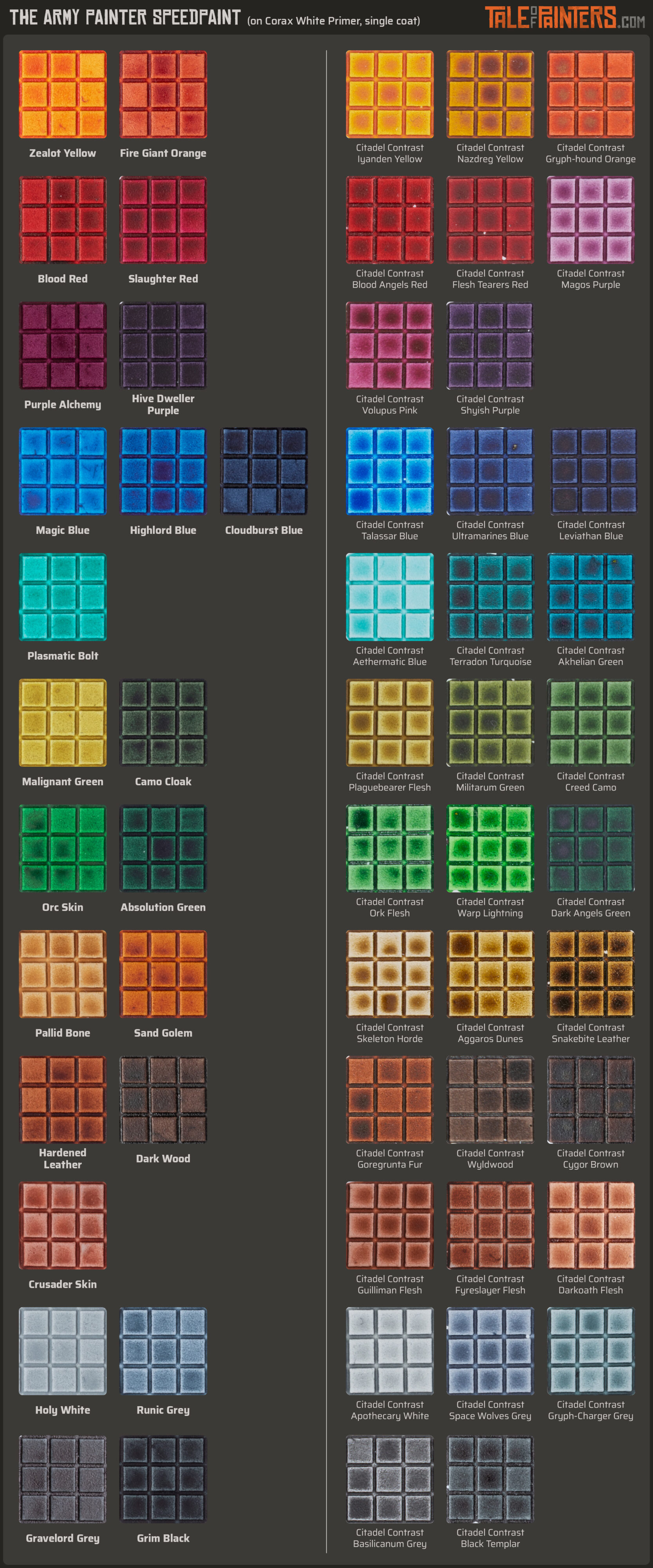

Magic Blue is a little darker and more intense than Talassar Blue, but with a little thinning it would be very similar. Highlord Blue is a little lighter and more of a prussian blue than Ultramarines Blue, while Cloudburst Blue is very similar to Leviathan Blue. In terms of turquoise, The Army Painter only has a single colour, Plasmatic Bolt, which is similar to Aethermatic Blue, but much deeper and darker.
For greens, we have Malignant Green, a light yellowish olive green that is quite similar to Plaguebearer Flesh. Camo Cloak is similar to Creed Camo, but a bit darker, Orc Skin is like a mix of Warp Lightning and Orruk Flesh. Absolution Green is similar to Dark Angels Green, but the highlights are more visible and the result is smoother.
Pallid Bone is a bit warmer and softer than Skeleton Horde, Hardened Leather is very similar to Gore-grunta Fur, while Sand Golem is a warm light brown. Dark Wood is like a mix of Wyldwood and Cygor Brown. Crusader Skin is a bit more reddish than Guilliman Flesh.
For greyscales, we have Holy White, which is a bit darker than Apothecary White but has softer shadows. It’s quite grey, so you might want to thin it down with a little bit of Speedpaint Medium. Runic Grey is very similar to Space Wolves Grey, while Gravelord Grey is darker than Basilicanum Grey. Grim Black is also bit darker than Black Templar, and has a slightly cool black hue whereas Black Templar has a slightly greenish black hue.
The Army Painter Speedpaint vs Contrast review
Now it’s time to put the new Speedpaints into practice.
The Army Painter recommend their Matt White Colour Primer, but for better comparison with Contrast, I used Grey Seer Spray from Games Workshop for both models, which is a light grey primer with a satin finish. The smooth satin finish allows the medium of Speedpaints and Contrast paints to spread more evenly. Nevertheless, the many flat areas of the Intercessors’ power armour will present quite a challenge for either paint.
When applying, I noticed that Speedpaints are a bit thinner and runnier than Contrast paints, and the medium pushes the paint into the recesses more aggressively, which helps to create a smoother result even on flat areas. On the other hand, I found Contrast paints slightly easier to control because of their higher viscosity. I felt it was easier to put them on smaller details without accidentally spilling into adjacent areas.
More about Contrast in my Contrast review here:
With both Speedpaints and Contrast, you’ll get the best result when you apply them generously, wait a little while for them to settle, and then soak up any excess with a damp brush where too much paint has gathered. This way, the medium can do its job and you’ll get a smoother result and more pronounced shading.
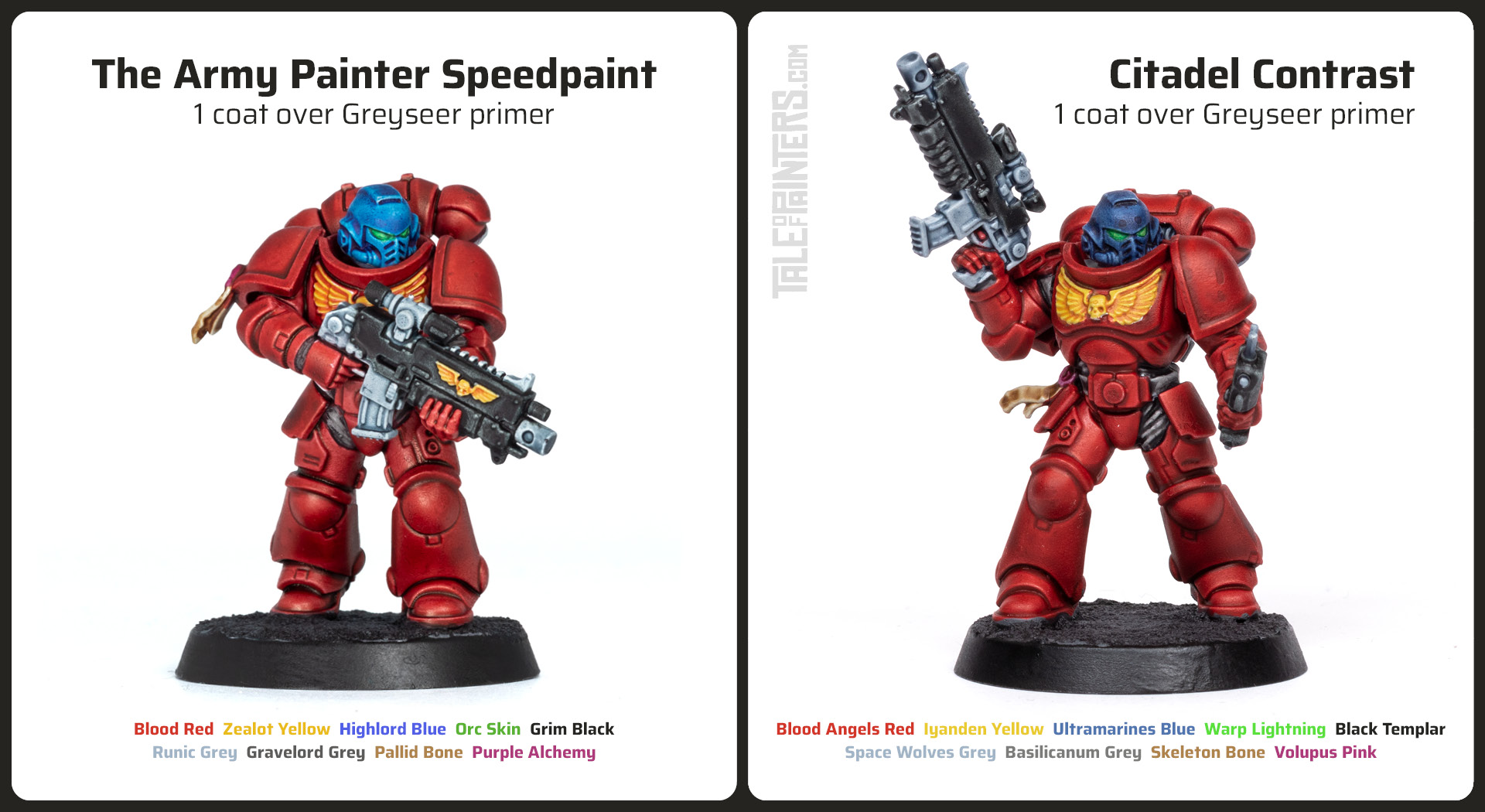

So here are the painted Blood Angels Space Marines. The red armour looks quite similar on both models, though there is a bit less pooling with Blood Red Speedpaint. The blue helmet looks much better on the Speedpaint version, and I also think that Grim Black Speedpaint looks slightly better than Black Templar Contrast on the bolt rifle. Zealot Yellow Speedpaint is a bit more orange than Iyanden Yellow but adds more definition to the chest eagle.
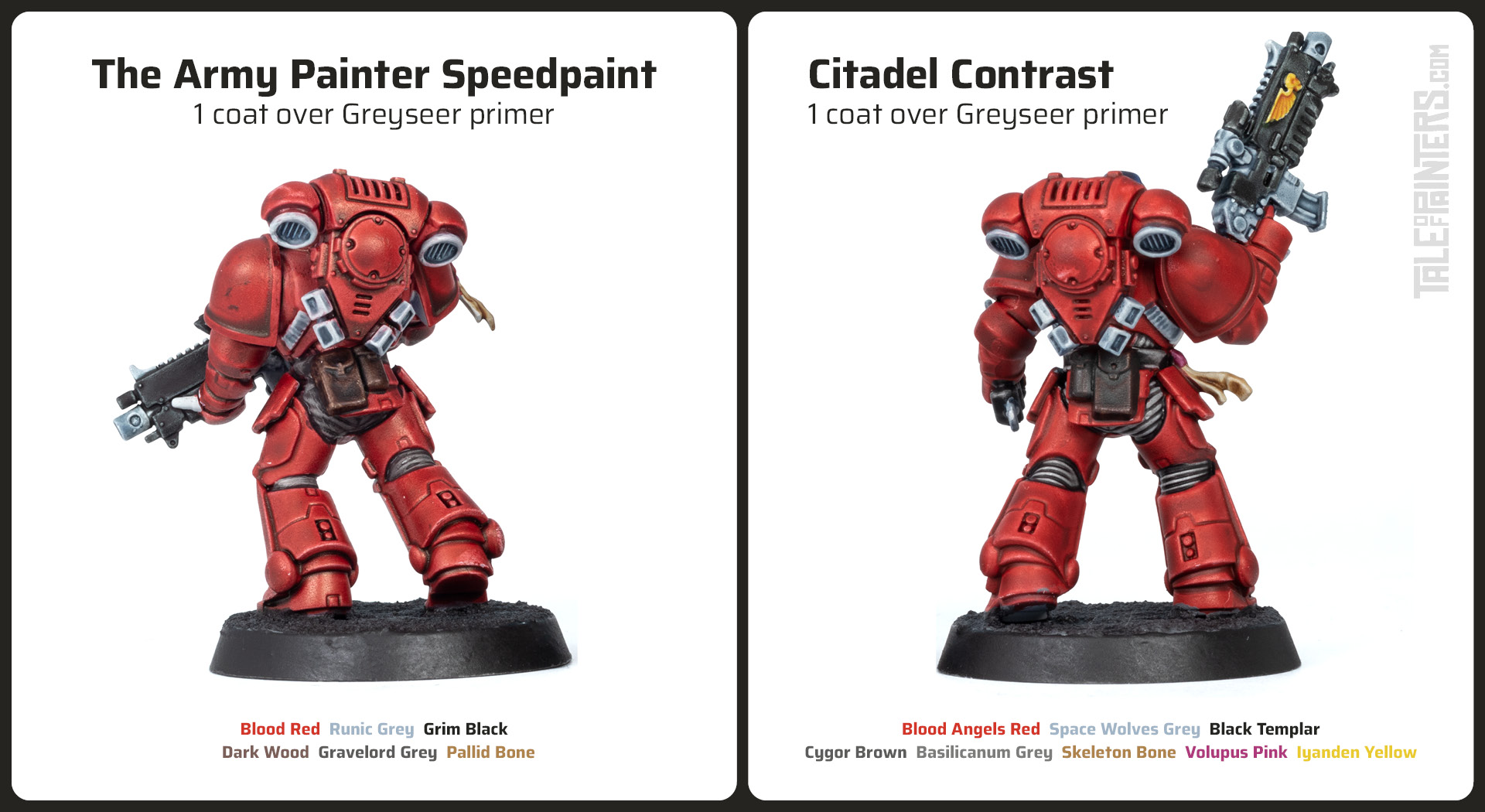

On the back, you can see that Basilicanum Grey Contrast on the undersuit looks more like a black wash, while Gravelord Grey Speedpaint adds more of a grey tint. The pouches painted with Cygor Brown are quite dark with only subtle highlights, while the ones painted with Dark Wood Speedpaint have more definition.
So, you can argue that Speedpaints produce more consistent results.
The reactivation issue
However, there is one thing I don’t like about Speedpaints that no one is really talking about: Even when they’re dried, they will reactivate when you paint over them. Here are some spots I wanted to touch up with Greyseer, and even though I applied multiple coats, the Blood Red Speedpaint keeps coming through, turning the Greyseer pink. I reached out to The Army Painter and they told me it is due to the composition of the medium and most prominent with Speedpaints containing a high amount of yellow pigments.
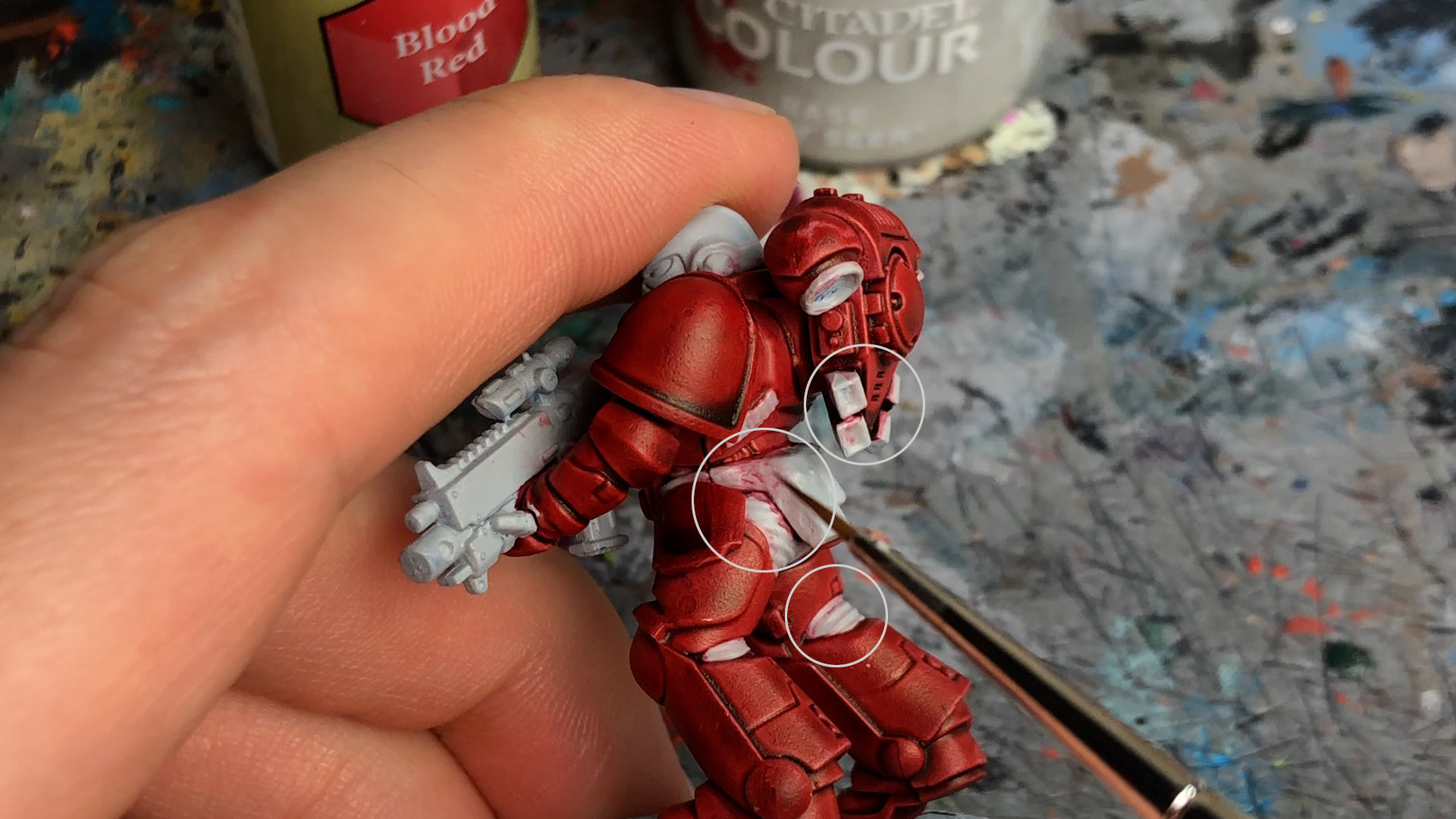

To find out which Speedpaints reactivate and which do not, I painted all of them on my trusty sheet of plasticard and let them dry for over 24 hours, to make sure that really all of the medium has evaporated. I’m using Spaceship Exterior Warpaint to paint over the left halves, and Corax White over the right halves, which are both very light greys. As you can see, no matter which Speedpaint I’m painting over, the paint reactivates and discolours my acrylic paint. Neither Warpaints or Citadel paints make a difference.
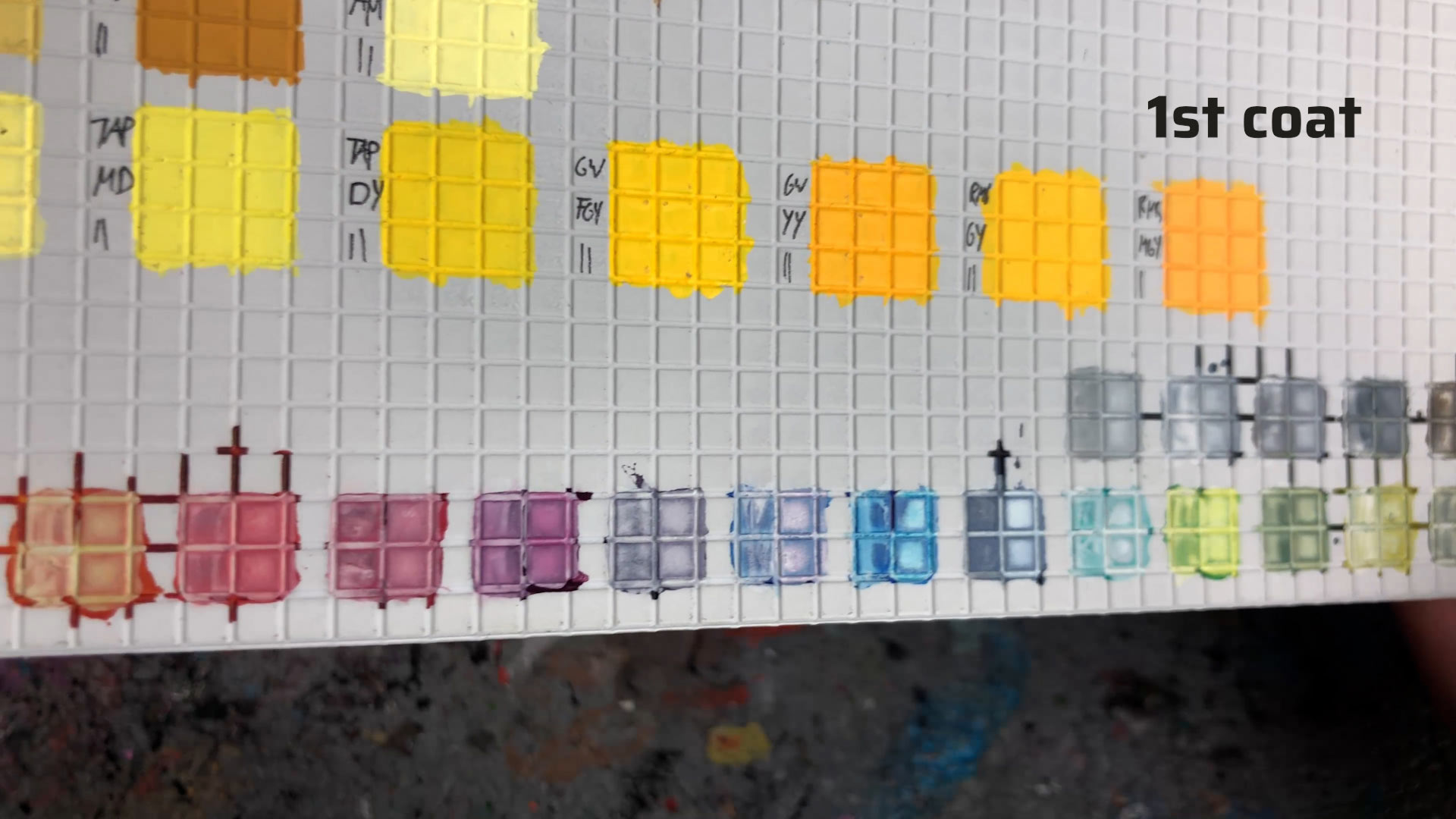

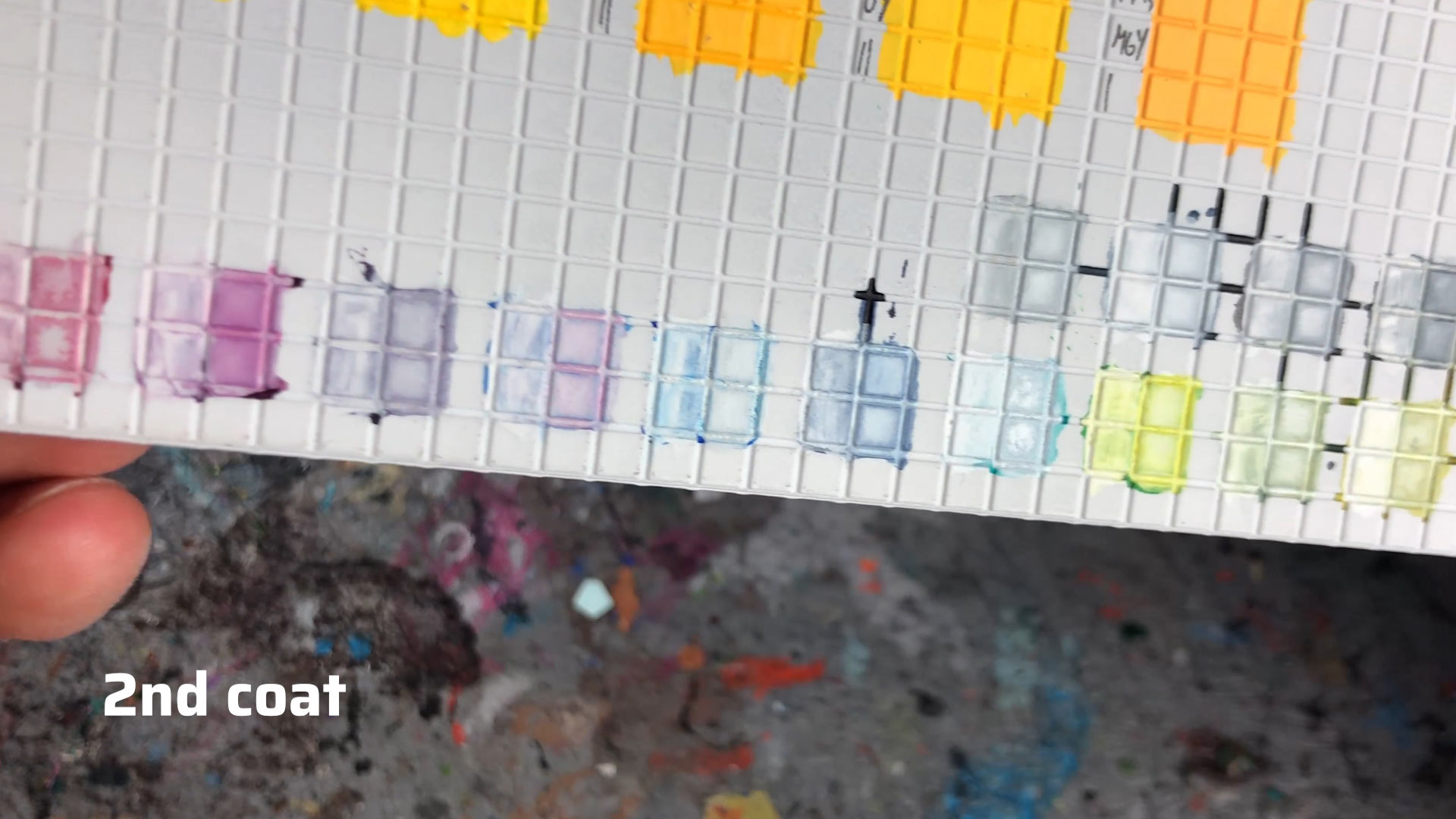

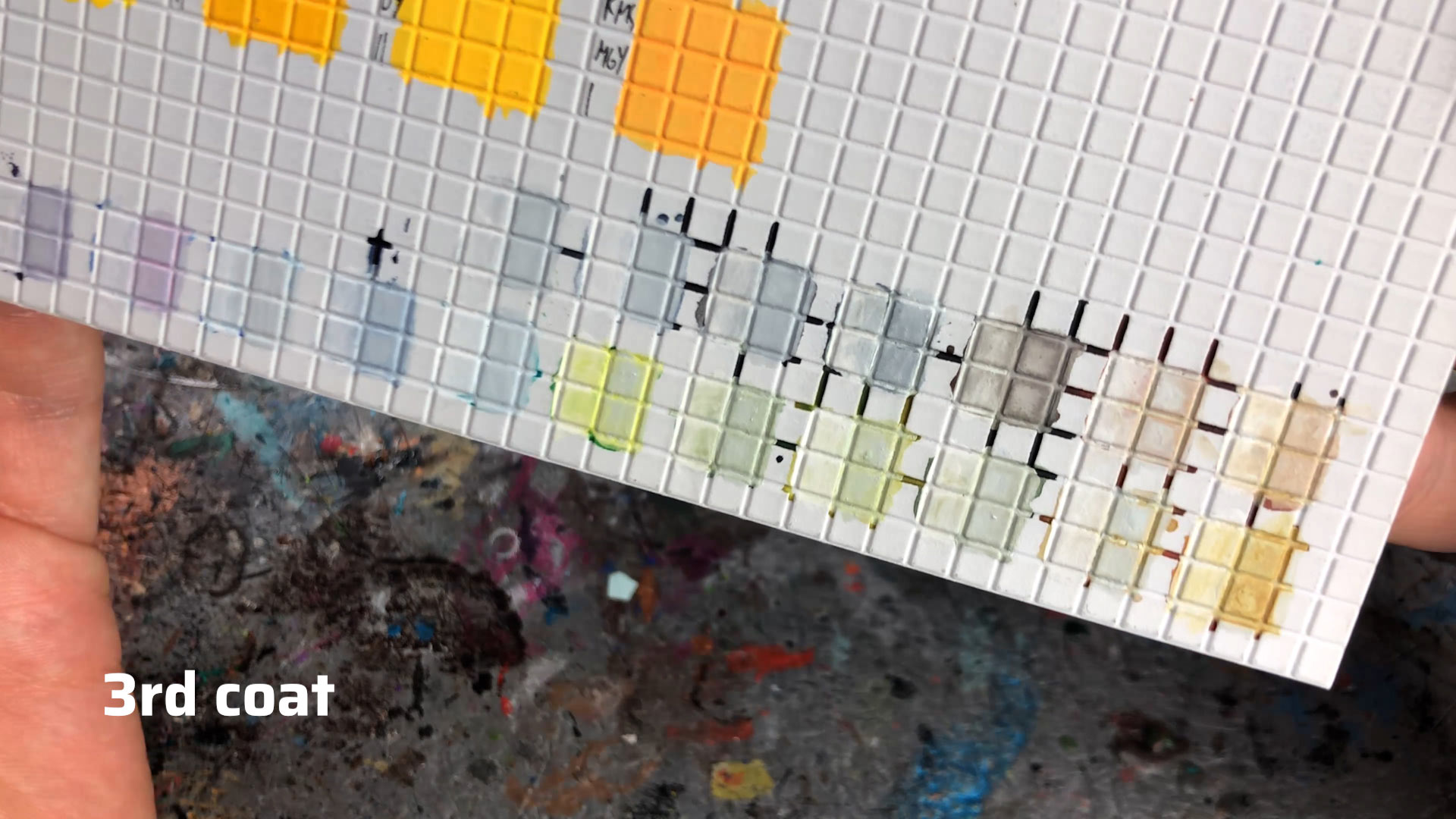

Here is what my test sheet looks like after a few coats of paints. And while it gets better with some of the less yellowish colours, the Speedpaints still bleed through the paint layers above, even after the third coat.
I found that a coat of varnish helps to fix the problem, but you have to be careful, as the varnish can reactivate the Speedpaints as well. It’s quite annoying because it’s not an issue at all with Games Workshop’s Contrast paints and limits the Speedpaints’ usefulness because the reactivation issue also means that Speedpaints aren’t really suitable for glazing techniques. A single thinned down coat might be fine, but when you glaze multiple layers of Speedpaints over another the paint will reactivate and mess up all your careful glazing work.
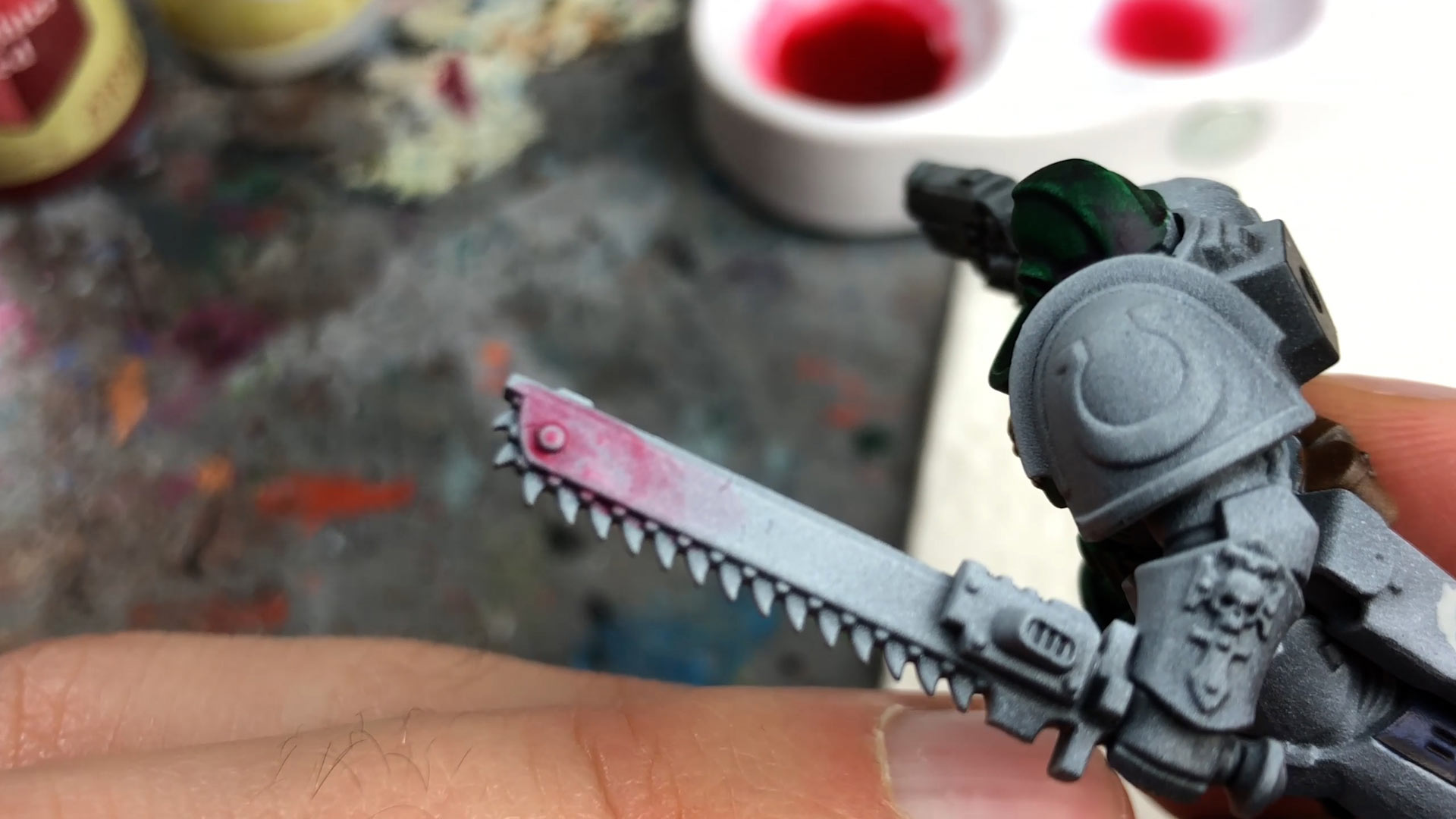

As a saving grace, I found if you just apply a few thin highlights in a similar colour to the Speedpaint you are painting over, the reactivation isn’t much of an issue.
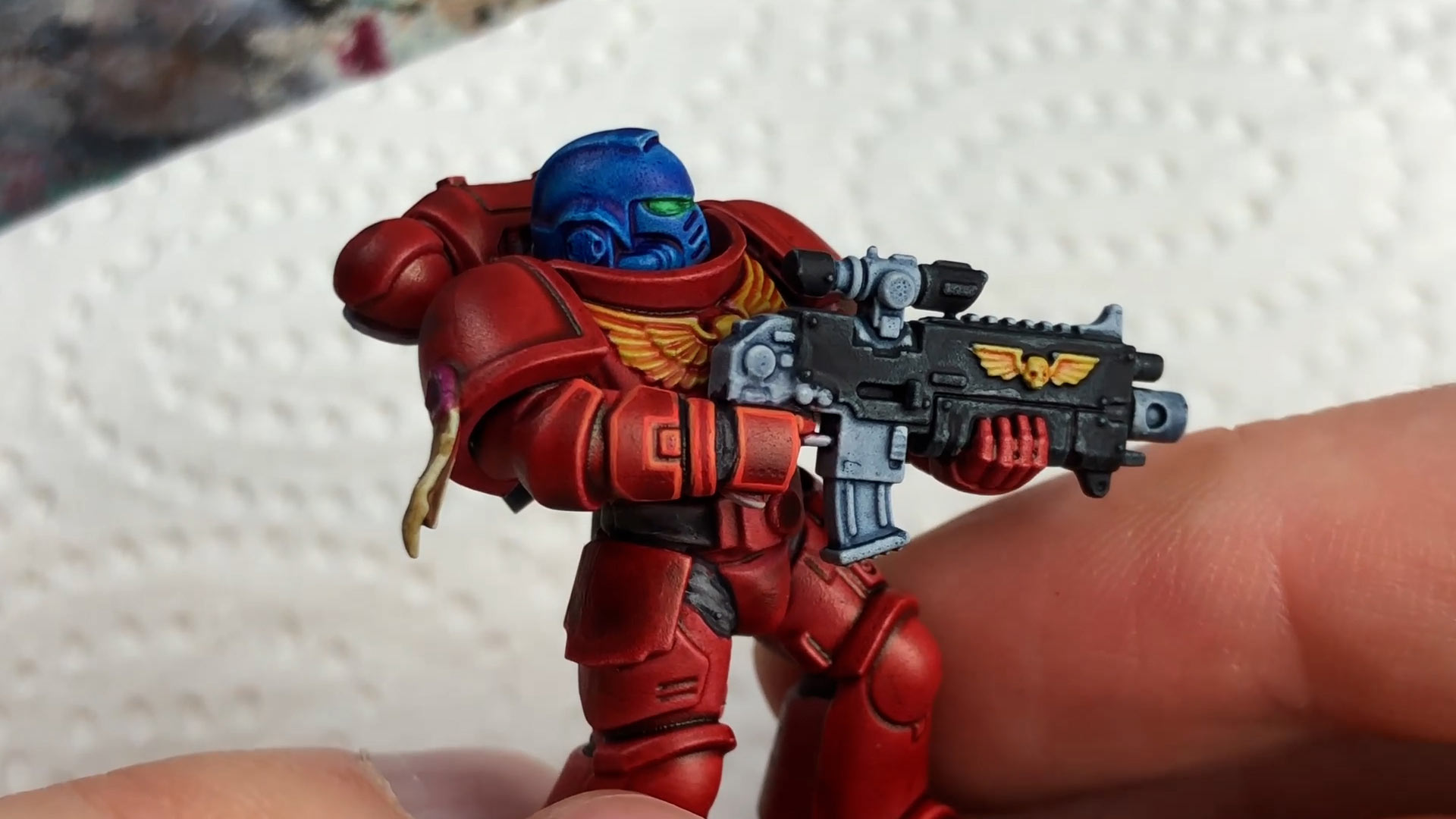

I also tried to apply a second coat of Speedpaint, here you can see Hardened Leather and Slaughter Red over Blood Red Speedpaint, as well as a wash of Purple Tone, and this turned out fine, as long as you don’t scrub over the dried Speedpaint with too much force. So, you have to think about how you are planning to use Speedpaints and decide if it might be an issue for you or not.
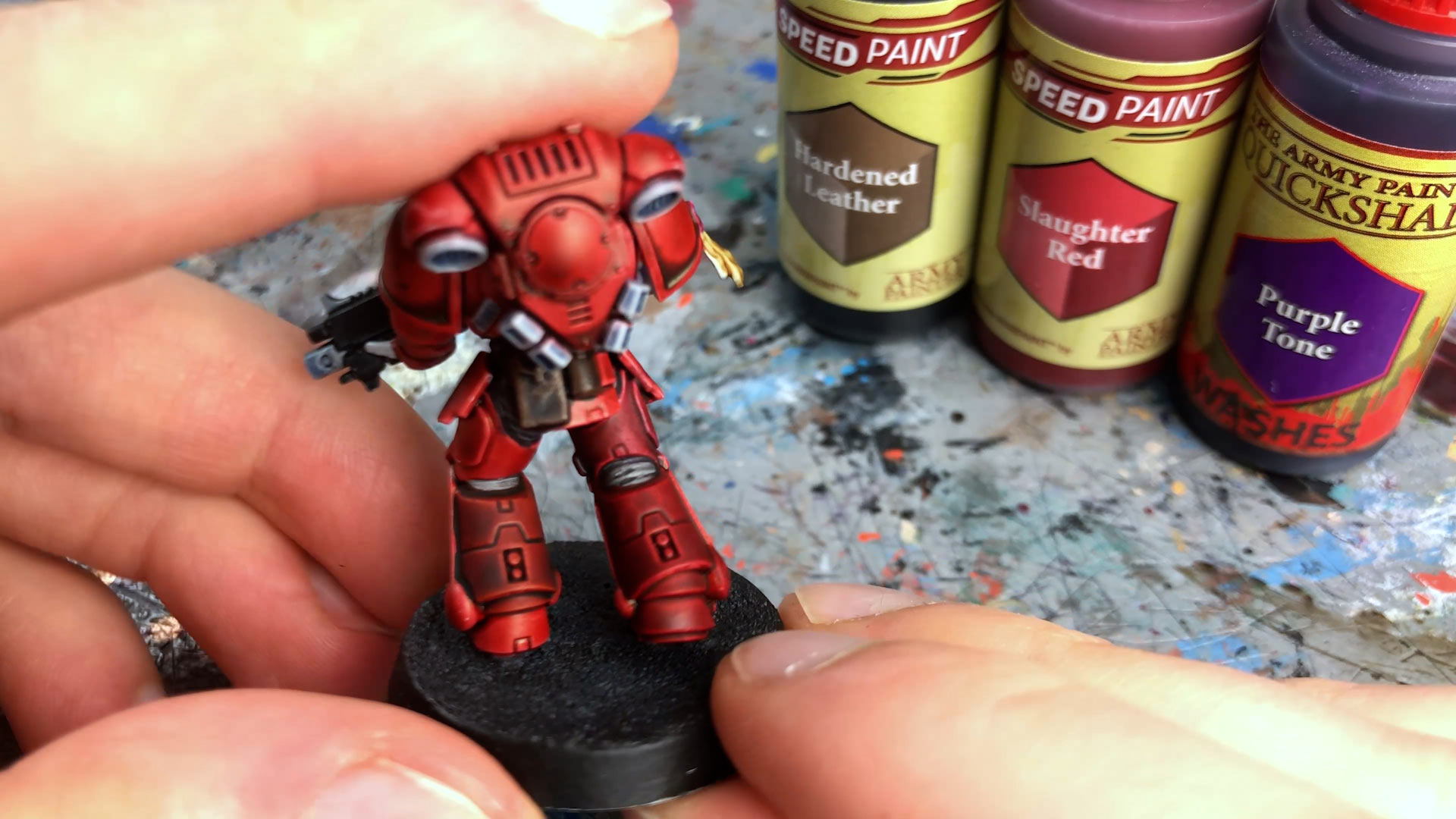

Last but not least, what about the resistance of Speedpaints? Well, not exactly good. They rub off very quickly, so you should definitely varnish your models. But Contrast paints have exactly the same problem, so this is a general issue of washes and inks of this kind.
Speedpaint on metallic basecoats and zenithal basecoats
Let’s proceed with some more tests and see how Speedpaints apply on a metallic basecoat. I sprayed an Intercessor with Plate Mail Metal from the Warpaints Air range, though you could also use Plate Mail Metal Colour Primer or Leadbelcher Spray.
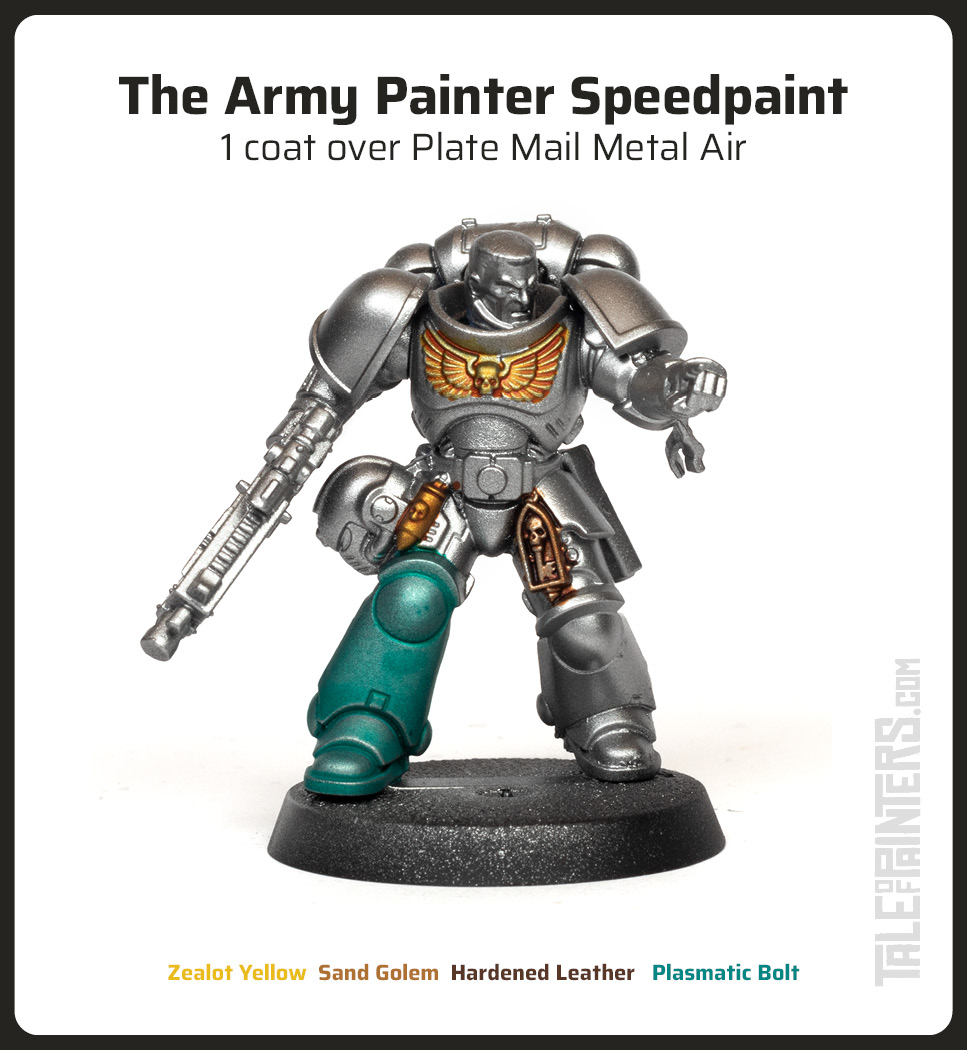

As you can see, the Speedpaints go on very nicely. With colours like Zealot Yelow, Sand Golem, and Fire Giant Orange you can create interesting shades of copper and gold or go wild and try out bolder metallic hues, like Plasmatic Bolt on the right leg.
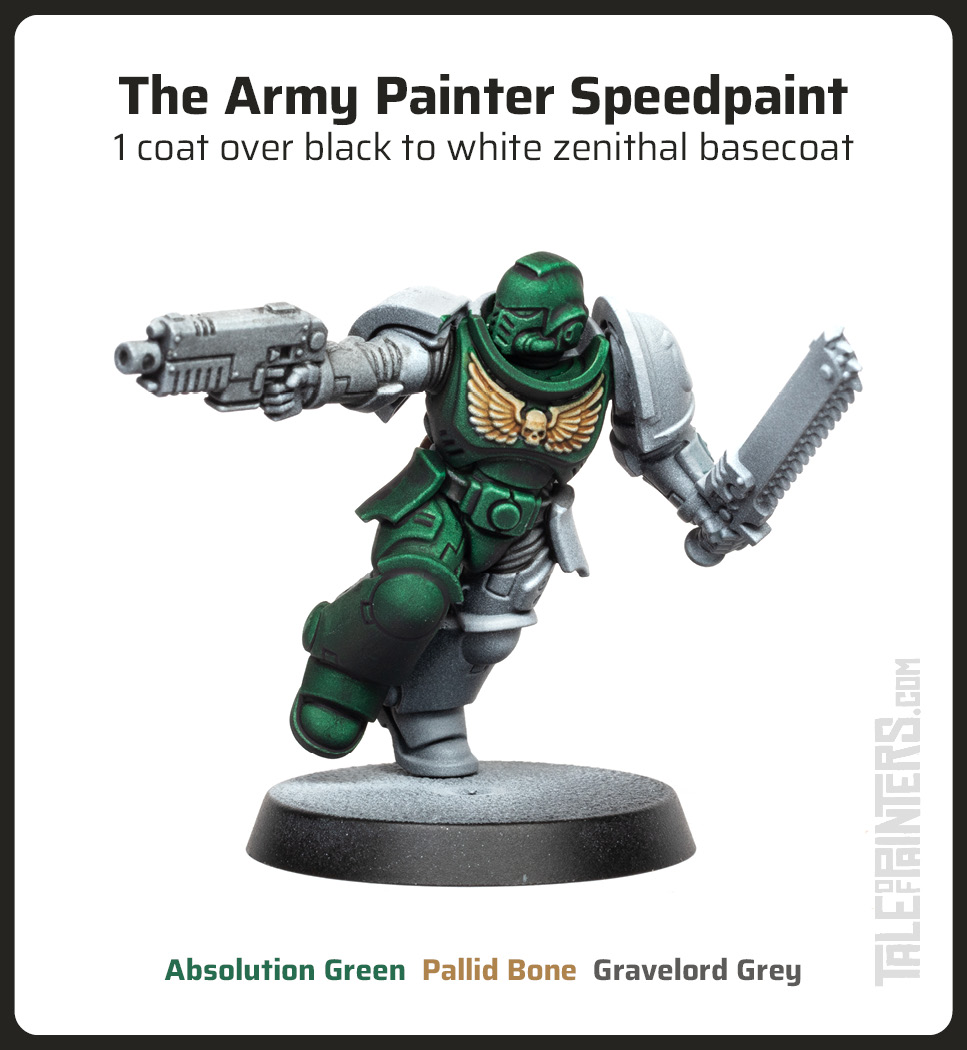

The next Space Marine was sprayed with Matt Black Colour Primer, and then been given a zenithal highlight of Matt White from The Army Painter’s Warpaints Air range. As you can see, applying Speedpaints over a zenithal basecoat can create awesome results in a short amount of time, as the black to white gradient adds even more depth to the Speedpaint effect.
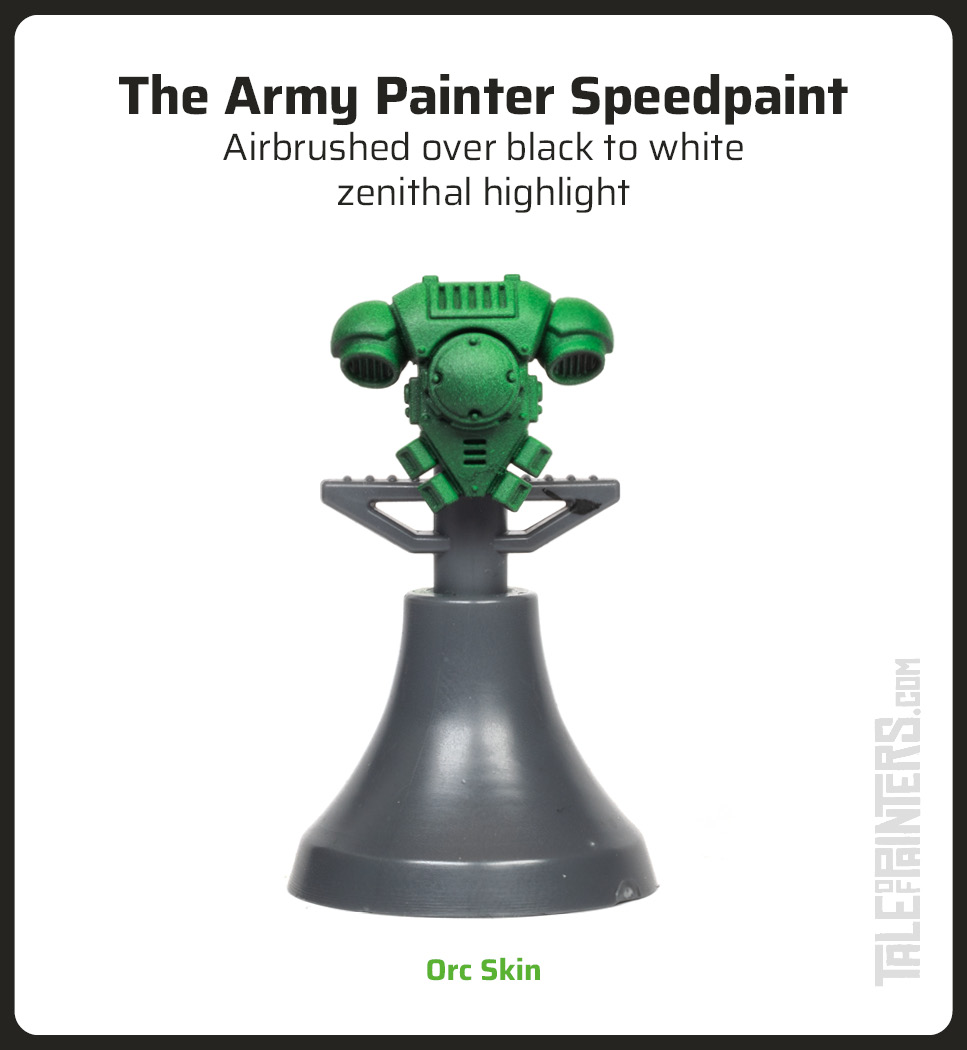

By the way, you can also apply Speedpaints with an airbrush. However, like acrylic inks and Contrast paints, they’ll act as a transparent filter but won’t run into the recesses like when applied with a brush, unless you really smother the model with paint, which I wouldn’t recommend. All of the shading on the backpack comes from the black to white zenithal basecoat, while the Orc Skin Speedpaint just added a transparent green layer.
Speedpaint vs Scale75 Instant Color and Antithesis from Warcolours
If you read this The Army Painter Speedpaint review so far, you’ll have a good impression of Speedpaints strengths and weaknesses. But how can Speedpaints compete with the other One Coat painting solutions like Instant Colours from Scale 75 and Antithesis paints from Warcolours?
The first thing to understand is that the latter two paint ranges have a very different formula than Contrast or Speedpaint. They are not based on dye, but on thinned acrylic pigments. Think of Citadel Nihiliakh Oxide or regular acrylic paints thinned with a lot of Contrast Medium.
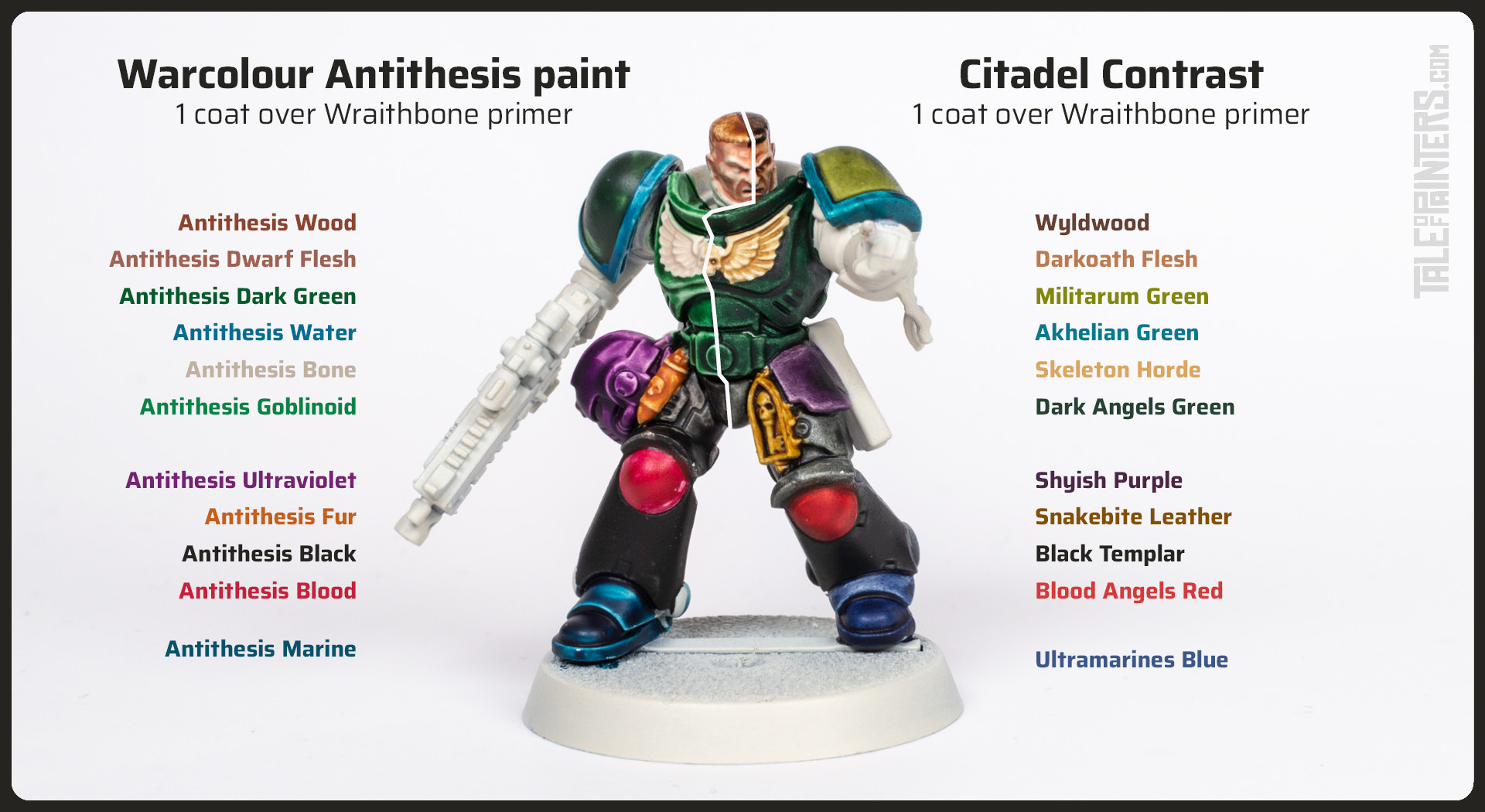

I didn’t like Antithesis Paints at all – they are far too thick, dry quite patchy and don’t settle well in the recesses. Instant Colours are more interesting because the range has a lot of muted and unusual colours to choose from. However, I found to use them more as coloured washes or glazes; as “one-coat paints” they are of limited use, as their pigment-based formula isn’t as powerful as Contrast or Speedpaints.
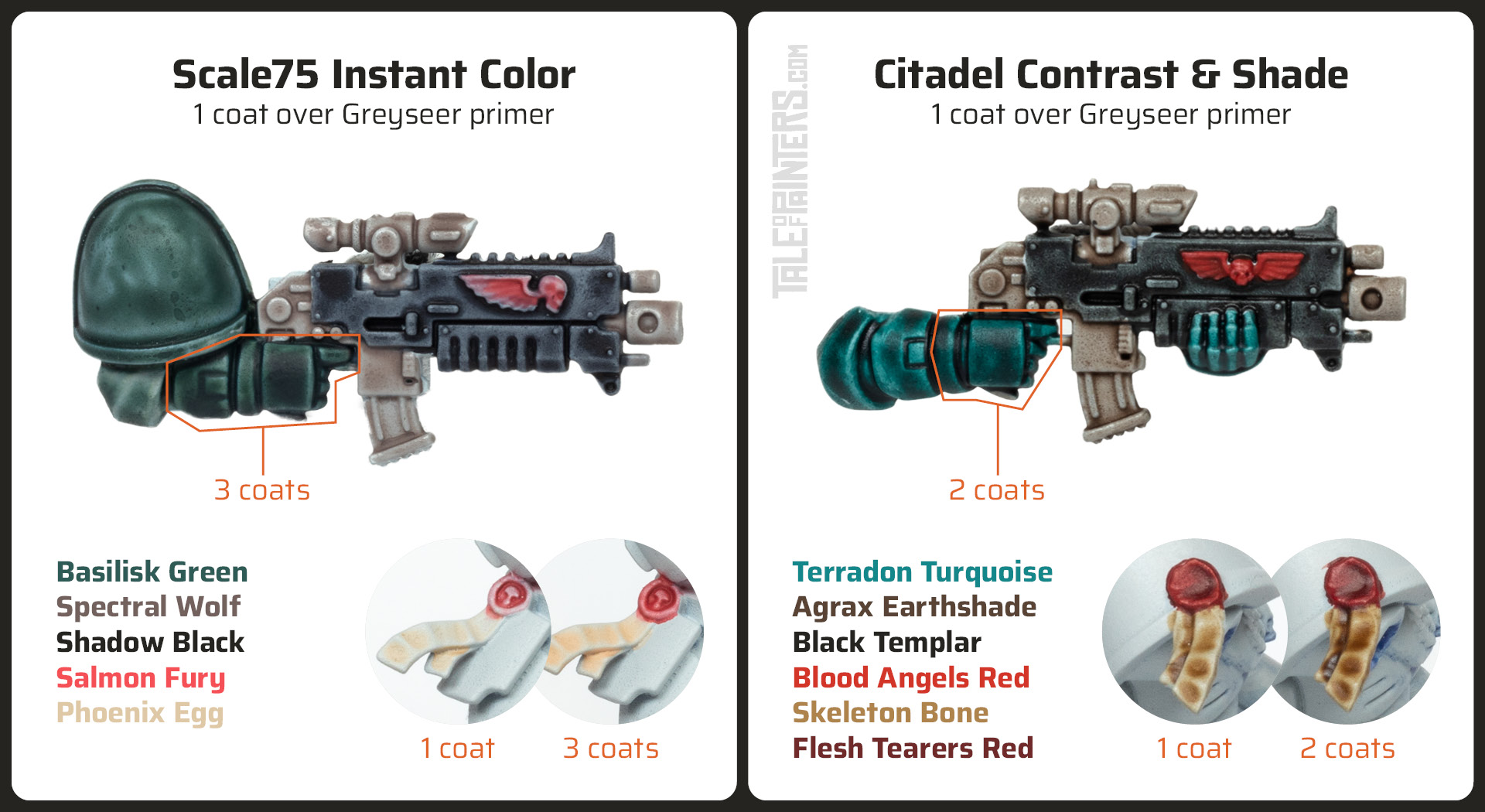

They often need multiple coats to achieve a similar level of richness. Also, the pigment-based formula doesn’t really work with zenithal shading, as the opaque pigments will gather in the dark recesses and make them brighter, which is not exactly what you want.
A detailed review of Warcolours Antithesis paints can be found here, and I’ve also written a review of Instant Colors a while ago:
Value
Both paint ranges have their merits, and it’s hard for me to pick a winner, BUT we also have to consider the price: With a unit price of 4 Euro or £3.75 over 6,30 Euro or £4.75 pounds for a pot of Contrast paint with the same 18 ml of paint, Speedpaints are about 35% cheaper (at least in Euro). I can’t deny there is a certain appeal to that, and if the high price tag of Contrast has deterred you so far, you should definitely give Speedpaint a try.
Speedpaints are available locally, on The Army Painter’s website, and at our partner stores Wayland Games and Element Games at an additional discount of up to 15%. Using our links for your next hobby purchase helps to support Tale of Painters at no extra cost at all, which we really appreciate 🙂
7.5Score
Pros
- First "true" one coat paint alternative
- Dropper bottles with mixing balls preinstalled
- Smoother results on flat areas
- Much cheaper than Contrast paints
Cons
- Less colours than Contrast
- Lower viscosity, slightly more difficult to control
- Reactivate when you paint or glaze over them
Final Verdict
With Speedpaint, The Army Painter has succeeded in bringing the first "real" Contrast alternative to the market, after Instant Colors and Antithesis Paints failed to become a true Contrast replacement. But is Speedpaint the BETTER product? Difficult to say. Both paint ranges have their pros and cons, as I pointed out in my review. Speedpaint does some things better and is much cheaper, but the reactivation issue is a significant limitation, and might even be a deal-breaker for some.








Thanks so much for this review and the comparisons – you have a lot of attention to detail and I appreciate all the pictures and explanations. I have old school paints and ink washes etc and haven’t tried contract paints or speedpaint yet. Speedpaint sounds so good but I’m a little worried about the “Reactivation”
Thanks for the review. Reactivation is a deal-killer for many painters, and I also dislike how other video “reviewers” don’t mention it. I guess the need for free product is great. Anyway, Goobertown Hobbies created a DIY contrast mix, and NotifyGrout posted his version on Lead Adventurers. It uses the same materials as Les Bursley’s wash, which I’ve been using for years and which the erstwhile Secret Weapon Miniatures used for their wash line.
NotifyGrout’s Goobertown Hobbies DIY Contrast mix:
* 1 drop matte medium
* 1 drop flow-aid water mixture (1:20)
* 1 drop acrylic ink
Also, search on “Les Bursley’s Wash”, which uses the same ingredients (or just add water).
Hello Cm, just read your comment. Would this DIY mix be a way of preventing reactivation of Speedpaint colors? Thank you very much 😉
Sorry for the late reply, but not sure! Army Painter says the speedpaint medium is “an innovative resin medium solution”. Dunno if that means it doesn’t use water, which most acrylic mediums use, or does. I can’t find any other acrylic paint mediums that use a resin medium solution.
Thanks for the review! Might I kindly ask for an expert opinion?
I recently started playing DnD with some friends and now I’m considering trying out painting miniatures as a potential hobby, but I literally have zero prior experience and no skills in drawing or painting.. So my question is, which set would you recommend for a total beginner like myself – the “Speedpaint Starter set” or “Nolzur’s Marvelous Pigments DnD Adventurers Paint set”?
I would normally go for Nolzur’s set because it is cheaper and comes with a miniature to practice on, but Speedpaint’s marketing of “base, shadow & highlight all in one” on the box makes it sounds like it could potentially compensate for my lack of skill or at least require less effort to produce similar results? Don’t even know if that makes any sense, but I would really appreciate a piece of advice on the subject! :))
I think it depends. I’d recommend the Nolzur set (which we reviewed here: https://taleofpainters.com/2019/04/review-army-painter-dungeons-dragons/) so you can learn the basic concepts of painting miniatures, before you can move to specialist paints like Speedpaints or Citadel Contrast. But if you just want quick results, go with Speedpaints. Just don’t forget you also need spray primer and matt varnish (a list of safe matt varnishes can be found here: https://taleofpainters.com/2022/02/top-tip-stahlys-best-matt-varnishes-for-painting-miniatures-spray-brush-on/).
You can also try Reaper Miniatures “Learn to Paint” Kits. IMO, The best way to learn how to paint is with a “hand holding” set of instructions. I do know that the Vallejo “D&D Paint Night Kit” has a step-by-step video to go with the kit. You do want a good brush tip, so either buy a cheap sacrificial pack of 00 synthetic brushes from Amazon (the tips wear out quickly, but it’s cheap and disposable), or a good expensive Kolinsky sable hobby brush, such as Raphael 8048 (?) or Winsor and Newton Series 7 ($15 for a brush, and requires brush care).
Brilliant comparison, really helped me decide to give these paints a go. Thanks